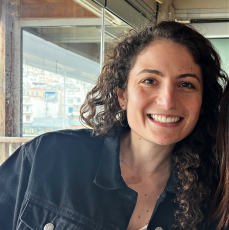In four days, we drove to four remote areas in Kiserian and Chepkalacha locations and met with four different IlChamus and Pokot communities. When I say “remote,” I do not exaggerate. Directed by CPI’s driver and logistics manager Francis, we maneuvered (way) off the beaten path, having to roll up the car windows to avoid getting punctured by branches. It didn’t seem like we had an exact destination, until seeing the area chief, reverend, or a few herders congregated together. Then we knew we had arrived. No Google Maps. No paper maps. And often no cell reception.
Our purpose was to conduct “fora peace outreach workshops,” and we did so for over 200 herders, warriors, women, and elders. CPI’s fora workshops engage pastoralist communities in the bush (or, the fora) to discuss the environmental and ecological challenges they are facing; explore the impacts of climate change; and develop coping mechanisms and strategic solutions to mitigate and adapt to these realities. Unsurprisingly, reduced pastureland and decreasing water sources were key topics of discussion, which led to open dialogue about competition and conflict between the two neighboring tribes.
In each workshop, we gathered in circles of over 50 men and women, with more men trickling into our group as the afternoon progressed. We asked about changes they have noticed in their environment and their cattle, beginning each question with “if” before “how.” This was to ensure that we were allowing individuals to speak for themselves without being pointed in one direction or another. For example, “If weather patterns have changed in the past 10-15 years, then how? If your cattle’s grazing patterns have changed over the past few years, then how? If water sources have changed, then how?” And critically, “how are you managing amidst these challenges?”
The participants divided into small discussion groups and took turns sharing their insights. Both groups noted that rainfall patterns have “completely changed.” They can no longer depend on the typical rainy season, which lasted roughly from March through May. Where there used to be an equal distribution of water over the course of some weeks, now there is a deluge of rain for a few days, then stops.
I learned about indigenous methods that the IlChamus and Pokot have used in the past to predict climate shifts like rainfall or drought. The IlChamus community in Ltepes location provided particularly interesting observations. They said that some fifteen years ago, they could depend on rain when the moon moved from west to east, or there were strong winds from the northern side, or when lightening struck from the east. Additionally, they used to study stars to predict weather patterns, but that has become difficult since stars are less visible. Furthermore, they noted changes in bird migration. It used to be that birds’ movement to their area signaled that rain was coming. Now, because of the extreme heat, the birds aren’t coming as often.
Learning about this indigenous knowledge was fascinating. This kind of information has to come directly from people with lived experience, and all the more exciting that I was there to listen. There is much more I have to share on our fora workshops including biodiversity loss and their consequences on cattle, so stay tuned!
Posted By Olivia Landau
Posted Jul 9th, 2024




2 Comments
Iain Guest
July 10, 2024
Absolutely fascinating, Olivia! Listening to stakeholders is the key to development and you have to meet them on their own terms, however uncomfortable that may be. So well done! As for their insights, I sort of get it that the birds would sense a change in patterns of rainfall, but what’s this about stars? Can’t wait to read more!!!
Mary Ellen Cain
July 20, 2024
Their astute observations about the weather, the night sky and bird migrations are really intriguing! I’m sure they find your knowledge about climate change and coping mechanisms to be very helpful, too. This must have made your rough trip into those remote areas worthwhile!